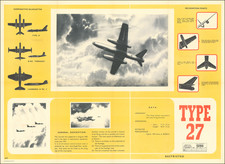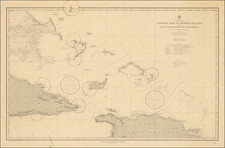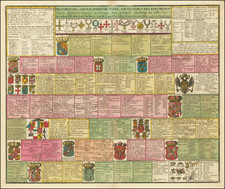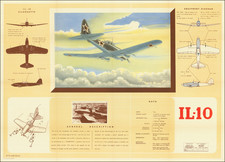Colorful, Detailed Lithographic Print Exhibiting the Port Signal Flags of Havana, Cuba
Fine view of the lighthouse and fortifications of the Castillo de los Tres Reyes del Morro, which protects the harbor of Havana, Cuba. The view is surrounded by a multitude of signaling flags, which is how the fort communicated with and about approaching vessels.
Published in 1853, the signals would help both naval and mercantile ships coming into and leaving Havana, a busy port. Just under the title, which explains that these signals are for the “Vijia del Morro,” a colloquial name for the castillo, are explanations and the view of the fort and the nearby waters. Flying in the wind on the bastions of the castillo are four flagpoles, or astas, and a telegraph pole. According to the legend:
1. The first is for the national flag, or pabellón. This flag is supposed to fly on all feast and gala days, and when war ships enter or leave the harbor.
2. This flagpole is for displaying identification signals of ships to the leeward, sotovento.
3. This flagpole is for displaying identification signals of ships to the windward, barlovento.
4. This is the small flagpole, for signals showing ship conditions, accidents, and requests.
5. A telegraph pole, which also flies signals indicating if a Spanish war ship is from the Havana station or another posting.
Below the view is an explanation of the types of ships that are signaled at present on the flagpoles. These include a French brigantine and a Spanish frigate, both merchant ships, to the leeward, and a Spanish steam-powered man-of-war to the windward, as well as another unknown ship. The steam ship is not posted to Havana, while the Spanish frigate is from Cádiz.
Tables arrayed around the central view explain the multitude of signals that can be flown from the castillo, as well as countersigns. As the example in the view illustrates, the signals are supposed to explain which ships are nearby, to leeward and windward, from where they hail, their purpose (mercantile or military), and their situation (in distress, in need of towing, on fire, etc.). The shape of the signal and number of signal flags, as well as their order, all share information about ships on the horizon.
Ringing the entire image are the flags of many trading nations and cities from Africa, Europe, Asia, and the Americas, which allow ships to be quickly identified. Below the signals is a note that explains that this document was approved by the Comandante General de Marina of Havana, where the lithographic print was published in accordance with the government.
Signal flags
Many people are familiar with signal flags as used on ships, a language of flags and pennants representing letters for messages and responses. This system was created in 1855, just after this document was published, and became more widespread in 1857. By the end of the century, it was the international standard and was revised in 1932.
However, prior to this signal system there were others, many siloed in national or imperial navies and merchant marines. For example, the Royal Navy of Britain adopted a system in 1803 invented by Sir Home Riggs Popham; it was used at the Battle of Trafalgar.
These, by contrast, are port signals, which have been less studied, and are less popular, than more modern ship signals. As Cuba was under the control of the Spanish in 1853, when this lithograph was printed, they used a Spanish system that would have been largely intelligible to Spanish commanders and navigators. It was most likely intelligible to sailors of other nations as well. However, a guide was still deemed helpful and of interest, for teaching and other purposes, hence the creation of this key.
Castillo de los Tres Reyes del Morro
The Castillo de los Tres Reyes del Morro has been protecting Havana Harbor for centuries. It sits at the mouth of the port, across from the Castillo de San Salvador de la Punta. Prior to the construction of the fortifications themselves, the morro—which translates to small hill or headland—had been used as a lookout point for ships, both friendly and less so.
As early as the 1530s, Spain ordered the village fortified. The first significant structure on the morro was begun in 1563, a watchtower. During this period, soldiers were stationed on the headland, acting as scouts. Construction proper began in 1589, with the arrival of Bautista Antonelli, military engineer. Antonelli made plans for a fort on the morro and across from it.
It took decades for the fort to be finished, a typical situation for a structure so large and for one located in a sprawling colonial empire. It was finally finished in the 1630s. 130 years later, in 1763, two other military engineers, Silvestre Abarca and Agustín Crame, had to begin to reconstruct the fort after the English occupation of the city in the Seven Years’ War.
An enduring feature of the Castillo de los Tres Reyes del Morro is its watchtower, long used as a lighthouse. Originally, the light was powered with firewood. At the beginning of the nineteenth century, the power source shifted to gas and then oil. The original tower was demolished a decade before this print was made and the Real Cuerpo de Ingenieros built the present tower, with its recognizable four windows, in 1844. This light, known as the Faro de O’Donnell, was electrified in 1945 and today the light can reach eighteenth miles out to sea.
Havana in the mid-nineteenth century
As indicated by the preponderance of Spanish flags in the title and within the signal tables, Havana at this time was still under Spanish control. Spanish conquistadores founded the town in 1519 in a bay known for its use in careening ships. Havana grew in importance as a trading center in the sixteenth century, inspiring imperial officials to fortify the bay as outlined above. In 1592, Havana was granted the title of city by Philip II.
By the mid-eighteenth century, Havana had 70,000 inhabitants, the third largest city in the Americas. The British managed to capture the city in 1762, which necessitate the repairs and new construction to the Castillo de los Tres Reyes del Morro in 1763. This was part of a larger fortification of the city that made Havana the most heavily-fortified city in the Americas.
By the mid-nineteenth century the city was a cultural center of the Spanish empire; it was known as the “Paris of the Antilles.” It was also a major Spanish naval base. The first railroad arrived in 1837, a line meant to transport sugar, which was grown using slave labor, to the harbor. Slavery was not abolished in Cuba until 1886.
The Castillo de los Tres Reyes del Morro was still regulating trade and monitoring ship traffic in the mid-nineteenth century, even though the days of pirate and privateer attacks were long past. The fort and its lighthouse are iconic sites of Havana Harbor, instantly recognizable on this lithographic print.









![Comparative Size of Lakes and Islands [Great Lakes, Cuba, Formosa, Ireland, Sicily, Cyprus, Vancouver, Sandwich Islands, Puerto Rico, Corsica, Sardinia, Balearics, Malta, etc]](https://storage.googleapis.com/raremaps/img/small/92574.jpg)
![Sphere De Ptolemee [with] Rose De Boussole…](https://storage.googleapis.com/raremaps/img/small/63929.jpg)



